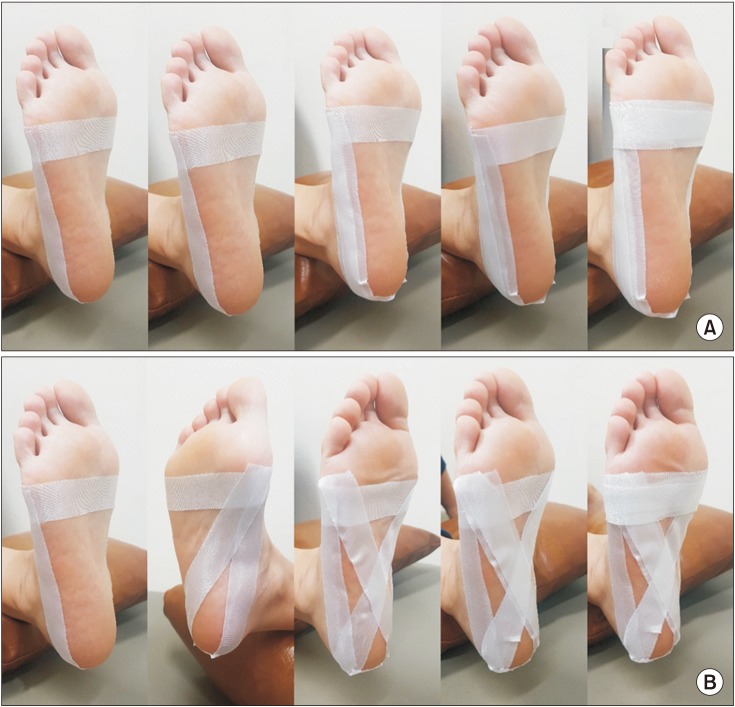Ann Rehabil Med.
2018 Apr;42(2):222-228. 10.5535/arm.2018.42.2.222.
Clinical and Biomechanical Effects of Low-Dye Taping and Figure-8 Modification of Low-Dye Taping in Patients With Heel Pad Atrophy
- Affiliations
-
- 1Department of Rehabilitation Medicine, Bundang Jesaeng General Hospital, Seongnam, Korea. taeim@hanmail.net
- 2Department of Rehabilitation Medicine, Samcheok Medical Center, Samcheok, Korea.
- KMID: 2432192
- DOI: http://doi.org/10.5535/arm.2018.42.2.222
Abstract
OBJECTIVE
To investigate and compare the effect of low-dye taping (LDT) and figure-8 modification of LDT (MLDT) on peak plantar pressure and heel pain in patients with heel pad atrophy.
METHODS
There were reviewed 32 feet of 19 patients who have been diagnosed with heel pad atrophy who were enrolled in this study. The patients were diagnosed with heel pad atrophy with clinical findings, and loaded heel pad thickness measured by ultrasonography. At the first visit, patients were taught how to do LDT and MLDT. They were instructed to do daily living with barefoot, LDT and MLDT at least one time per day. Patients performed pedobarography with barefoot, LDT and MLDT within 2 weeks. The severity of heel pain was also checked with the visual analogue scale (VAS) during daily living with barefoot, LDT and MLDT.
RESULTS
VAS of hindfoot were significantly decreased after LDT and MLDT (p < 0.01). Peak plantar pressure under hindfoot were also decreased after LDT and MLDT (p < 0.01). The effect of MLDT in decreasing peak plantar pressure of hindfoot (p < 0.01) and pain relief (p=0.001) was better than the effect of LDT.
CONCLUSION
The LDT technique is clinically useful for pain management and reducing peak plantar pressure of hindfoot in patients with heel pad atrophy. MLDT is more effective than LDT in reducing peak plantar pressure and heel pain in patients with heel pad atrophy.
Figure
Reference
-
1. Saxelby J, Betts RP, Bygrave CJ. ‘Low-dye’ taping on the foot in the management of plantar fasciitis. Foot (Edinb). 1997; 7:205–209.2. Radford JA, Landorf KB, Buchbinder R, Cook C. Effectiveness of low-dye taping for the short-term treatment of plantar heel pain: a randomised trial. BMC Musculoskelet Disord. 2006; 7:64. PMID: 16895612.
Article3. Park C, Lee S, Lim DY, Yi CW, Kim JH, Jeon C. Effects of the application of Low-Dye taping on the pain and stability of patients with plantar fasciitis. J Phys Ther Sci. 2015; 27:2491–2493. PMID: 26355306.
Article4. Van Lunen B, Cortes N, Andrus T, Walker M, Pasquale M, Onate J. Immediate effects of a heel-pain orthosis and an augmented low-dye taping on plantar pressures and pain in subjects with plantar fasciitis. Clin J Sport Med. 2011; 21:474–479. PMID: 22011796.
Article5. Landorf KB, Keenan AM, Herbert RD. Effectiveness of foot orthoses to treat plantar fasciitis: a randomized trial. Arch Intern Med. 2006; 166:1305–1310. PMID: 16801514.6. Ha HS, Hwang JH, Kim YB, Ha YM, Hwang JM. Immediate clinical and biomechanical effects of lowdye taping in patients with plantar heel pain. Korean J Sports Med. 2012; 30:9–15.
Article7. Lange B, Chipchase L, Evans A. The effect of low-dye taping on plantar pressures, during gait, in subjects with navicular drop exceeding 10 mm. J Orthop Sports Phys Ther. 2004; 34:201–209. PMID: 15128190.
Article8. Vicenzino B, McPoil T, Buckland S. Plantar foot pressures after the augmented low dye taping technique. J Athl Train. 2007; 42:374–380. PMID: 18059993.9. O'Sullivan K, Kennedy N, O'Neill E, Ni Mhainin U. The effect of low-dye taping on rearfoot motion and plantar pressure during the stance phase of gait. BMC Musculoskelet Disord. 2008; 9:111. PMID: 18710520.10. Yi TI, Shim JW, Ku HK, Seo IS, Huh WS, Kim JS, et al. The effects of modified low-dye taping in the patient with heel pad atrophy. J Korean Acad Rehabil Med. 2011; 35:96–100.11. Yi TI, Lee GE, Seo IS, Huh WS, Yoon TH, Kim BR. Clinical characteristics of the causes of plantar heel pain. Ann Rehabil Med. 2011; 35:507–513. PMID: 22506166.
Article12. Turgut A, Gokturk E, Kose N, Seber S, Hazer B, Gunal I. The relationship of heel pad elasticity and plantar heel pain. Clin Orthop Relat Res. 1999; (360):191–196.
Article13. Pfeffer G, Bacchetti P, Deland J, Lewis A, Anderson R, Davis W, et al. Comparison of custom and prefabricated orthoses in the initial treatment of proximal plantar fasciitis. Foot Ankle Int. 1999; 20:214–221. PMID: 10229276.
Article14. Russo SJ, Chipchase LS. The effect of low-dye taping on peak plantar pressures of normal feet during gait. Aust J Physiother. 2001; 47:239–244. PMID: 11722292.
Article15. Nolan D, Kennedy N. Effects of low-dye taping on plantar pressure pre and post exercise: an exploratory study. BMC Musculoskelet Disord. 2009; 10:40. PMID: 19383160.
Article16. Newell T, Simon J, Docherty CL. Arch-taping techniques for altering navicular height and plantar pressures during activity. J Athl Train. 2015; 50:825–832. PMID: 26098272.
Article17. Radford JA, Burns J, Buchbinder R, Landorf KB, Cook C. The effect of low-dye taping on kinematic, kinetic, and electromyographic variables: a systematic review. J Orthop Sports Phys Ther. 2006; 36:232–241. PMID: 16676873.
Article18. SMCBC Curriculum Committee. Manual of athletic taping. Philadelphia: F. A. Davis;1995. p. 26–30.19. Rhee WI, Kim JM. Ultrasonographic findings of thickness and compressibility of heel pads in outpatient. J Korean Soc Med Ultrasound. 2004; 23:213–218.20. Del Rossi G, Fiolkowski P, Morodyski MB, Bishop M, Trimble M. For how long do temporary techniques maintain the height of the longitudinal arch? Phys Ther Sport. 2004; 5:84–89.
- Full Text Links
- Actions
-
Cited
- CITED
-
- Close
- Share
- Similar articles
-
- Immediate Clinical and Biomechanical Effects of Low-dye Taping in Patients with Plantar Heel Pain
- The Effects of Modified Low-Dye Taping in the Patient with Heel Pad Atrophy
- Effect of Weight-bearing Pattern and Calcaneal Taping on Heel Width and Plantar Pressure in Standing
- Immediate Effect of Calf Muscle Kinesio Taping on Ankle Joint Reposition Sense and Force Sense in Healthy Elderly
- Effects of Balance Taping Therapy for Elders with Leg Pain


